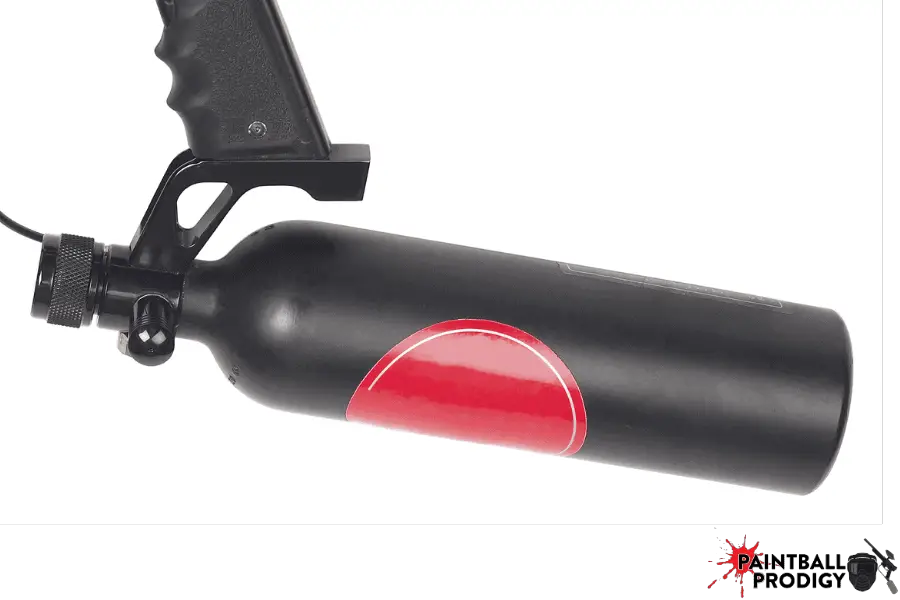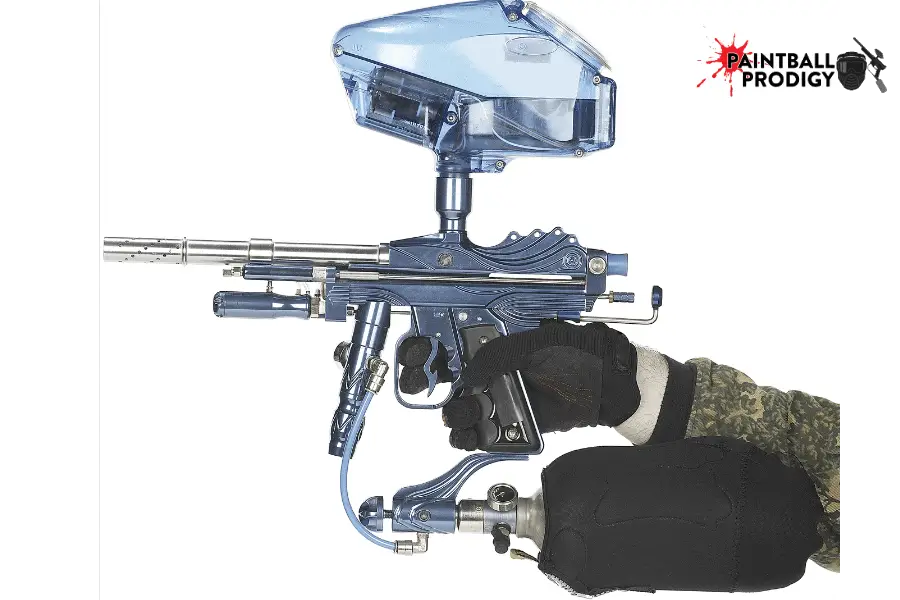Many paintball players are rightfully concerned about how they can ship paintball tanks properly to various destinations in the world. With the increased security concerns in airports, it’s essential to understand the rules that govern shipping compressed air cylinders to prevent your package from being seized while in transit.

So, can you ship a paintball tank? Yes, you can ship a paintball tank. However, it has to be empty. If it contains CO2 or pressurized air, it will be considered hazardous and might not be allowed on a plane or cargo carrier.
In this post, we’ll explain everything you need to know about shipping a paintball tank. You will also learn a few safety tips for shipping paintball tanks correctly.
Why You Cannot Ship a Pressurized Paintball Tank
Different shipping companies may have different standards. However, most companies do not allow pressurized air cylinders.
Even if you don’t care about the safety implications, you still shouldn’t ship a pressurized tank because it might be confiscated. Cargo inspectors will open any package whenever they have doubts or suspicion about it.
And they will check it – an X-ray scanner would reveal the canister to any shipment inspecter, and they will almost certainly check to see if it’s filled or not.
Okay, that’s great – but what are the potential consequences of shipping a pressurized tank? What are the shipping companies so worried about?
Here are a few possibilities:
- Pressurized tanks can explode. This a danger to everyone who participates in the shipping chain.
- The companies don’t want to risk shipping a tank that can over-expand from the lower air pressure, as most of the time, the package is loaded in an unpressurized cargo area underneath the plane.
- The cylinder can be exposed to freezing temperatures while flying at high altitudes, thus affecting the structural integrity of the tank. Icing is common at high altitudes.
- You have to remove the regulator before shipping the tank by air. This way, the inspectors can verify that it is indeed empty. Gauges can misread and even break. However, with the regulator removed, the inspectors know it can’t hold any pressure.
- In addition, if the regulator is off, it means pressure change won’t affect the paintball tank as it would with an airtight cylinder. The possibility of a cylinder bursting on a plane is taken very seriously, and every measure has to be put in place to prevent such scenarios.
You can’t even board a flight with a medical cylinder unless you get special clearance from TSA. They also inspect the cylinder to ensure it can fly with the pressure changes.

How to Ship a Paintball Tank
When it comes to shipping air cylinders, you have a few options at your service. Freight carriers like FedEx, USPS, and UPS allow you to ship air cylinders without removing the regulator.
As mentioned above, you have to remove the contents of the cylinder before shipping. By removing the contents, the cylinder will no longer be considered hazardous, and you can ship it to any destination with no issues. To remove the gas from the cylinder, you’ll need to remove the regulator.
Note: If you cannot remove the regulator yourself, you should visit a local sport or paintball store for help. But here is a very helpful article with video instructions, I created for you about removing a regulator.
When packaging the cylinder, place it in a box with lots of padding and filler so that the movement during transit doesn’t damage the tank or box.
When re-installing the regulator, make sure you tighten the regulator to remove all space between the neck of the cylinder and the bottom of the regulator.
If you hand-tighten the regulator, make sure to use the back of the cylinder when removing it from the marker. This action is important in ensuring the regulator doesn’t separate from the tank upon removal.
Can A Paintball Tank Explode During Shipping?
As we mentioned before, paintball tanks can explode during shipping transit. There are a few reported cases of paintball tank explosion and injuries caused by the blast.
Here are a few reasons why a paintball tank might explode during transportation:
A Pressurized Tank at High Altitude Could Be a Ticking Time Bomb
An increase in elevation reduces atmospheric pressure. And a decrease in atmospheric pressure allows the gas inside a tank to expand, resulting in a higher internal pressure because there is little atmospheric pressure pushing on it. This decrease in atmospheric pressure can cause the tank to explode
Moral of the story? Don’t take a pressurized paintball tank on an airplane.
As the atmospheric pressure reduces on a pressurized tank, the gas inside expands, resulting in a higher internal pressure because there is little atmospheric pressure pushing on it. This can cause an explosion.
Poorly Made Tank
All paintball tanks are not equal. Some manufacturers make cheaper tanks than others do, and this decrease in quality can impact the tank’s structural integrity. If the paintball tank has a weak structure, it can buckle and explode while in transit.
An Old Tank
Like other things, paintball tanks lose structural integrity as they get older. The lifespan of a paintball tank is about 15 years if well-taken care of, so think twice before shipping a tank that is older than that.
Physical Damage to the Tank
Physical damage is the leading cause of paintball tank explosions in transit. Paintball is a sport that involves a lot of running, jumping, hiding, and even diving. As such, paintball tanks can take a lot of damage over their lifespan.
Little chips and small scratches might not be a problem, but deep gorges should definitely be a source of concern. If you ship a pressurized tank with deep cracks, you’re basically asking for an explosion.
Additional Tips for Shipping Paintball Tanks and Other Paintball Accessories
Here are some extra tips for shipping or traveling with paintball tanks and other paintball gear:
- If you’re planning on traveling with a paintball tank, visit the TSA website for the state or country you are visiting and print out the TSA travel regulations. With this information in your hands, you can make clear to skeptical TSA officials that you are allowed to travel with your paintball gear.
- Tell the person who will be checking your bag that you are flying with paintball gear. By informing them, they can arrange for a quick check of your bag so that you don’t risk missing your flight.
- To let the officials at the airport know it is paintball gear, you can include a picture from a newspaper or magazine that includes your gear, marker, and other useful details.
Conclusion
If you want to ship a paintball tank, you’ll need to release all of the gas or air from the tank before boxing it up and handing it to your shipment facilitator. You must do this because shipping a paintball tank that has gas or air in it is dangerous, and can result in an explosion during transit.
If you do remove the gas or air from your tank, shipping it is a relatively easy process. Make sure you get a box that is slightly bigger than the cylinder and fill it with dense packing material like packing paper or bubble wrap. This will prevent the tank from moving around or becoming damaged during transit.
